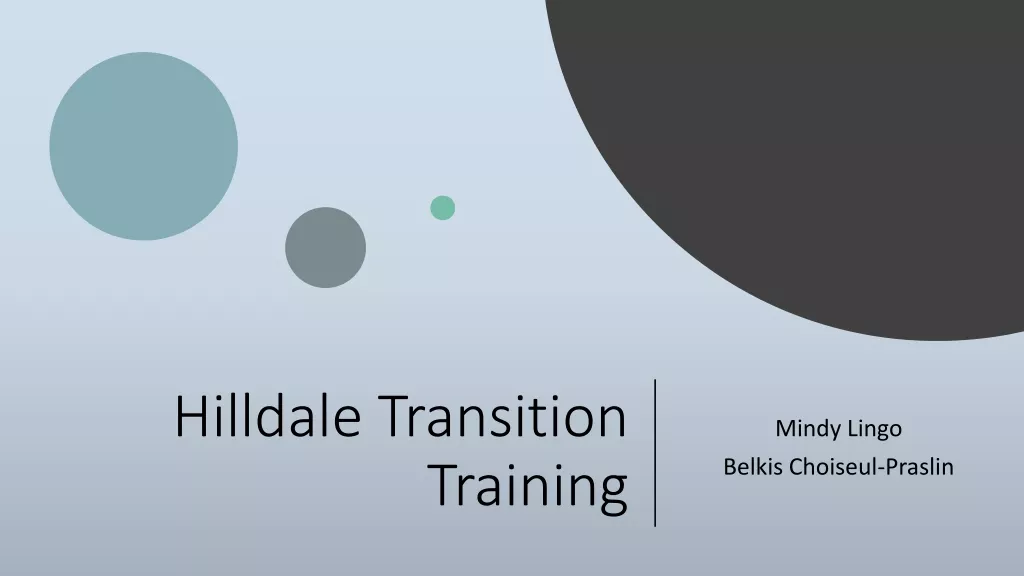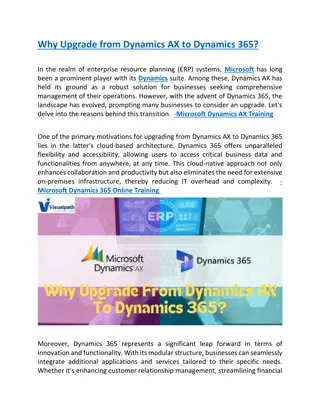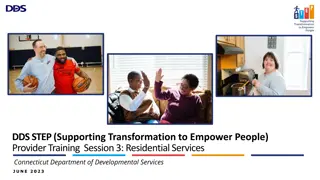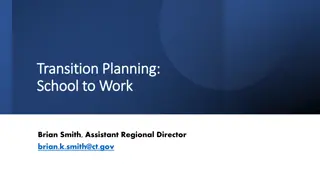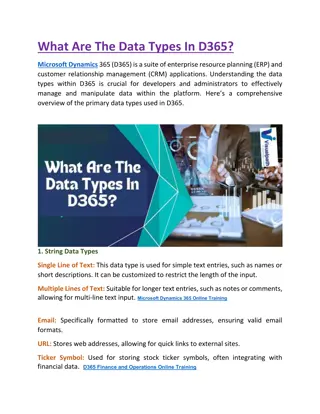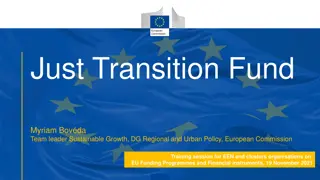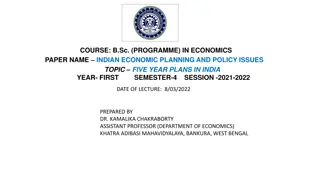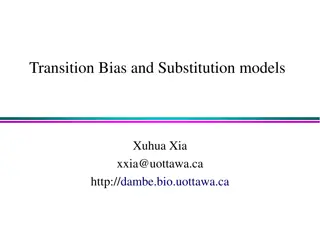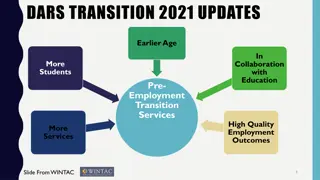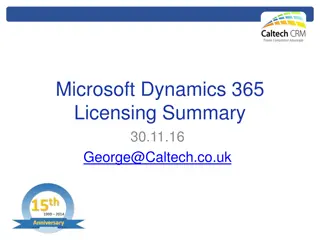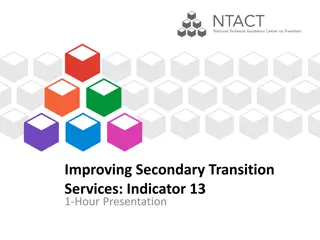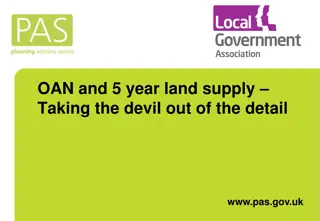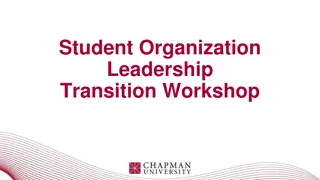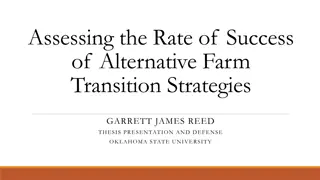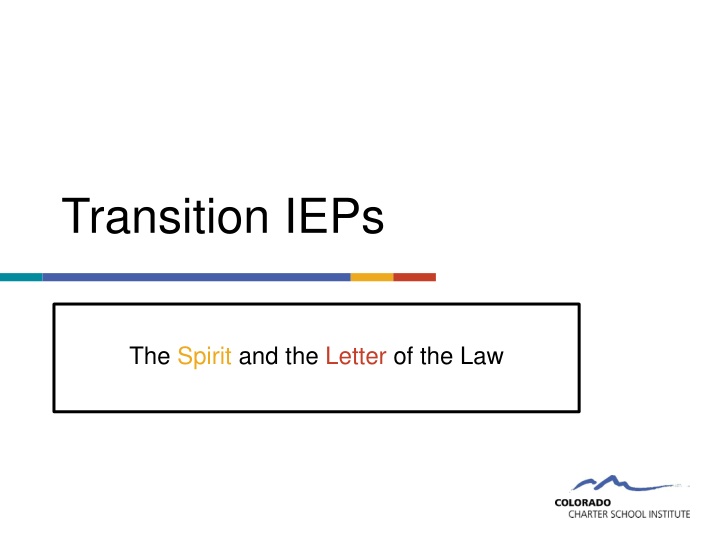
Transition Planning Dynamics
The intersection of Spirit and Letter perspectives in transition planning, focusing on holistic visioning and compliance with legal requirements for successful outcomes. Explore the nuances of student-driven development and compliance-driven strategies.
Download Presentation

Please find below an Image/Link to download the presentation.
The content on the website is provided AS IS for your information and personal use only. It may not be sold, licensed, or shared on other websites without obtaining consent from the author. If you encounter any issues during the download, it is possible that the publisher has removed the file from their server.
You are allowed to download the files provided on this website for personal or commercial use, subject to the condition that they are used lawfully. All files are the property of their respective owners.
The content on the website is provided AS IS for your information and personal use only. It may not be sold, licensed, or shared on other websites without obtaining consent from the author.
E N D
Presentation Transcript
Transition IEPs The Spirit and the Letter of the Law
Vacation Planning: The Spirit Needs: relaxation and connection Possibilities: Beach, backpacking, family visit Barriers: Budget, energy level, toddler stamina Goal: Family visit to North Carolina Solution to barriers: Stay with mother-in-law The Spirit of Travel
Vacation Planning: The Letter ID? Passport or Visa? Boarding pass? Enough underwear? Charger? Car seat? Binky? The Letter of Travel
Vacation Planning: The Spirit and the Letter Spirit Letter Passenger-driven Holistic Visualizes the possibilities Anticipates barriers Solves for barriers Develops a plan Logistically-driven Linear Based on minimal requirements Checks boxes Prevents cancellation Ensures safety
Transition Planning We often start (and lose ourselves) here: Indicator 13 Inventories and assessments Postsecondary activities Specific, measurable, achievable, relevant, time- bound Compliance Golden thread Signature uploads Education goals, career goals, independent living goals, annual goals, oh my! The Letter of the law
Transition Planning But like with travel planning, we need both! Spirit Letter Student-driven Holistic Visualizes the possibilities Anticipates barriers Solves for barriers Develops a village Compliance-driven Linear Based on minimal requirements Checks boxes Prevents lawsuits Ensures equity
Six Components of Transition Planning 1. Conduct assessments 2. Write post-secondary goals statements 3. Write annual IEP goals 4. Identify transition services 5. Describe courses of study 6. Coordinate with adult agencies The Golden Thread
Lets explore each of these components using the Spirit and Letter lenses
Component 1: Assessments Spirit Letter Help the student consider: Who am I? When and where am I at my best? What are my unique interests? What are my barriers to success? How can I tackle those barriers? When I get stuck, who is my network? Include formal and informal measures Add at least one new assessment each year Ensure that the assessments are age- appropriate and individualized
More on Assessments Assessment Finder Assessment Summary Example: After taking the O*NET Interest Profiler, Jenny identified a PSG of being an architect and attending a four-year university. Jenny s mathematics performance remains significantly below grade level and Jenny s current math score on CO state testing does not meet the freshman requirement for entrance into any four-year college in the state of Colorado. Although Jenny s initial goal was to attend a four-year university, further conferencing and a visit to the local community college s office of disabilities led Jenny to decide to pursue an associate s degree in architectural drafting.
Component 2: Post-Secondary Goals Statements Spirit Letter Update annually Will do Include two or three domains: 1. Education 2. Career 3. Independent living (if relevant) Dream! Visualize! Ask questions & solve for barriers: 1. Schooling 2. Work 3. Life (if relevant)
More on Post-Secondary Statements Post-Secondary Goal Examples: Education/Training: After high school, Jenny will attend AIMS Community College to complete a 2-year degree in Architectural Drafting. Career/Employment:After completing her associate s degree in architectural drafting, Jenny will obtain employment as an assistant in the field of architecture. Independent Living: Based on Jenny s transition body of evidence and completion of the Casey Life Skills Brief Assessment, there are no independent living needs at this time.
Component 3: Annual IEP Goals Spirit Letter Ensure they are SMART (Specific, Measurable, Achievable, Relevant, Time-Bound) Relate to transition services Link to post-secondary goals Anticipate barriers or skill deficits that may prevent a quality life after high school Write goals that close those gaps and solve for those barriers
More on Annual IEP Goals Annual IEP Goal Examples: Education/Training: By March of 2025, in order to comprehend information while attending a community college, when given a grade-level reading passage and literal questions to answer, Jose will effectively use annotation strategies to determine the meaning of the passage as evidenced by four out of five correct responses. Career/Employment: By March of 2025, in order to calculate scaled blueprints as an architectural assistant, when given a set of grade-level equations, Jenny will determine the correct operation and apply correct computational strategies as evidenced by eight out of ten accurate solutions.
Component 4: Transition Services Spirit Letter Design specialized instruction Directly link to annual goals Use the words Will provide Engage the student (must be invited to the meeting) Ask: Who are the student s key people until graduation who can help them close the gaps which jeopardize their future quality of life? What will services need to look like in order to close those gaps?
More on Transition Services Transition Activities Examples: Tour or research postsecondary programs Research and contact local college disability services Instruction in self-advocacy/disability awareness Internships/job shadows Instruction in budgeting Supported public transportation exploration
More on Transition Services Transition Service Statement Examples: The special education teacher will provide Chris with training on maintaining a planner to keep track of college assignments. The speech language pathologist will work with Cooper on using his AAC device to request activities during his day. The school psychologist will provide Laurie with opportunities to learn and practice conflict resolution and impulsivity control to support Laurie s success in a shop as an auto mechanic. The special education teacher will accompany Vivian to the Aveda Institute for a cosmetologist observation.
Component 5: Courses of Study Spirit Letter Align with postsecondary goals and transition services Describe in narrative form (not just a generic list of grad requirements) Include a multi-year description Identify specific courses that would best help the student close the gaps which jeopardize their success after high school
More on Courses of Study Courses of Study Examples: In order for Jenny to meet the entrance requirements for AIMS Community College s Architectural Drafting Associate s Program, Jenny will take Geometry in the Real World and a computer-aided drafting STEM course in addition to her core classes. During his Junior and Senior years, Joseph will take courses required to meet graduation requirements and prepare for entrance into the Air Force. Joseph will take Tech Lab classes to learn about basic technology for electronic skills needed in the military. Finally, Joseph will take an additional PE course to prepare for the physical demands of the military.
Component 6: Coordination with Adult Agencies Spirit Letter Facilitate linkages and referrals Obtain parental consent to invite outside agencies to IEP meetings Commit other agencies to provide services only with agency participation and approval Envision the student s village Involve their village Equip their village
More on Adult Agency Coordination Adult Agency Example: A representative from AIMS Community College s SSD office attended Leo s transition IEP meeting (with prior consent from parents) and is supporting Leo and his team throughout the application and enrollment process. The SSD office will take Leo s IEP accommodations into consideration as they develop an access plan for his college classes.
Six Components of Transition Planning 1. Conduct assessments (at least one new age-appropriate, individualized, formal or informal assessment per year) Write post-secondary goals statements (updated annually, including two or three domains, written in active voice) Write annual IEP goals (must be SMART, linked to post-secondary statements and related to transition services) Identify transition services (actively worded, specially designed instruction which is related to annual goals with student present at meeting) Describe courses of study (narrative, multi-year description which is aligned with post-secondary goals and transition services) Coordinate with adult agencies (facilitate linkages with parent consent and agency approval for agency involvement) 2. 3. 4. 5. 6. The Golden Thread
Thank you! After your team has written an IEP in the spirit of transition IEP law and is ready to audit their work, use this Transition IEP Checklist to ensure you are meeting the letter of the law.


